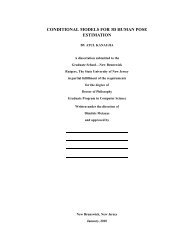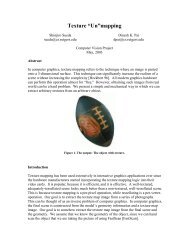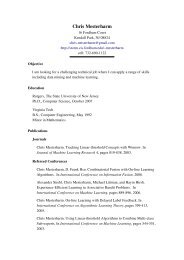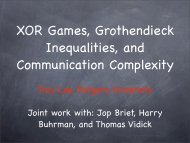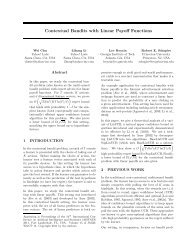Knows What It Knows: A Framework for Self-Aware Learning
Knows What It Knows: A Framework for Self-Aware Learning
Knows What It Knows: A Framework for Self-Aware Learning
You also want an ePaper? Increase the reach of your titles
YUMPU automatically turns print PDFs into web optimized ePapers that Google loves.
<strong>Knows</strong> <strong>What</strong> <strong>It</strong> <strong>Knows</strong>: A <strong>Framework</strong> <strong>for</strong> <strong>Self</strong>-<strong>Aware</strong> <strong>Learning</strong><br />
Lihong Li<br />
lihong@cs.rutgers.edu<br />
Michael L. Littman<br />
mlittman@cs.rutgers.edu<br />
Thomas J. Walsh<br />
thomaswa@cs.rutgers.edu<br />
Rutgers University, Department of Computer Science, 110 Frelinghuysen Dr., Piscataway, NJ 08854<br />
Recent rein<strong>for</strong>cement-learning (RL) algorithms<br />
with polynomial sample-complexity guarantees<br />
(e.g. (Kearns & Singh, 2002)) rely on distinguishing<br />
between instances that have been learned with<br />
sufficient accuracy and those whose outputs are still<br />
unknown. This partitioning allows algorithms to<br />
directly manage the exploration/exploitation tradeoff.<br />
However, prior frameworks <strong>for</strong> measuring sample<br />
complexity in supervised learning, such as Probably<br />
Approximately Correct (PAC) and Mistake Bound<br />
(MB), do not necessarily maintain such distinctions,<br />
so efficient algorithms <strong>for</strong> learning a model in these<br />
paradigms can be insufficient <strong>for</strong> efficient RL. In<br />
this work, we describe the <strong>Knows</strong> <strong>What</strong> <strong>It</strong> <strong>Knows</strong><br />
(KWIK) framework (introduced by Li et al. (2008)),<br />
which intrinsically relies upon the known/unknown<br />
partitioning, embodying the sufficient conditions <strong>for</strong><br />
sample-efficient exploration in RL. We show that several<br />
widely studied RL models are KWIK-learnable<br />
and derive polynomial sample-complexity upper<br />
bounds within this framework.<br />
A KWIK algorithm begins with an input set X output<br />
set Y , and observation set Z. The hypothesis class<br />
H consists of a set of functions from X to Y : H ⊆<br />
(X → Y ). The target function h ∗ ∈ H is unknown to<br />
the learner. H and parameters ǫ and δ are known to<br />
both the learner and environment. The environment<br />
selects a target function h ∗ ∈ H adversarially. The<br />
agent then repeats the following:<br />
1. The environment selects an input x ∈ X adversarially<br />
and in<strong>for</strong>ms the learner.<br />
2. The learner predicts an output ŷ ∈ Y ∪{⊥} where<br />
⊥ means “I don’t know”.<br />
3. If ŷ ≠ ⊥, it should be accurate: |ŷ −y| ≤ ǫ, where<br />
y = h ∗ (x). Otherwise, the entire run is considered<br />
a failure. The probability of a failed run must be<br />
bounded by δ.<br />
4. If ŷ = ⊥, the learner makes an observation z ∈ Z<br />
of the output, where z = y in the deterministic<br />
case, z = 1 with probability y and 0 with probability<br />
1 − y in the Bernoulli case, or z = y + η <strong>for</strong><br />
zero-mean random variable η with additive noise.<br />
Over a run, the total number of steps on which ŷ = ⊥<br />
must be bounded by B(ǫ, δ), ideally polynomial in 1/ǫ,<br />
1/δ, and parameters defining H. We refer to B(ǫ, δ) as<br />
the KWIK bound. Note that this bound should hold<br />
even if h ∗ ∉ H, although, obviously, outputs need not<br />
be accurate in this case.<br />
Like PAC, a KWIK algorithm is not allowed to make<br />
mistakes. Like MB, inputs to a KWIK algorithm can<br />
be selected adversarially. Instead of bounding mistakes,<br />
a KWIK algorithm must have a bound on the<br />
number of label requests (⊥) it can make. By requiring<br />
per<strong>for</strong>mance to be independent of the distribution,<br />
a KWIK algorithm can be used in cases in which the<br />
input distribution is dependent in complex ways on the<br />
KWIK algorithm’s behavior, as can happen in on-line<br />
or active learning settings. We note that any KWIK<br />
algorithm can be turned into an MB algorithm (and<br />
there<strong>for</strong>e PAC) by simply guessing instead of signaling<br />
⊥, but cases exist where the reverse is not possible.<br />
We now present some fundamental KWIK algorithms<br />
to give a flavor of how the framework can be applied in<br />
simple situations. The memorization algorithm can be<br />
used when the input space X is finite and outputs are<br />
observed noise free. To achieve this bound, it simply<br />
keeps a mapping ĥ initialized to ĥ(x) = ⊥ <strong>for</strong> all x ∈<br />
X. When the environment chooses an input x, the<br />
algorithm reports ĥ(x). If ĥ(x) = ⊥, the environment<br />
will provide a label y and the algorithm will assign<br />
ĥ(x) := y. <strong>It</strong> will only report ⊥ once <strong>for</strong> each input,<br />
so the KWIK bound is |X|.<br />
The enumeration algorithm keeps track of Ĥ, the version<br />
space. Each time the environment provides input<br />
x ∈ X, the algorithm computes ˆL = {h(x)|h ∈ Ĥ}.<br />
If |ˆL| = 1, it means that all hypotheses left in Ĥ<br />
agree on the output <strong>for</strong> this input, so this element<br />
is returned. If |ˆL| > 1, two hypotheses in the version<br />
space disagree and the algorithm returns ⊥ and
<strong>Knows</strong> <strong>What</strong> <strong>It</strong> <strong>Knows</strong>: A <strong>Framework</strong> <strong>for</strong> <strong>Self</strong>-<strong>Aware</strong> <strong>Learning</strong><br />
receives the true label y, pruning the version space accordingly.<br />
<strong>It</strong> then computes an updated version space<br />
Ĥ ′ = {h|h ∈ Ĥ ∧ h(x) = y} that contains at least one<br />
fewer hypothesis than the old version space. If |Ĥ| = 1<br />
at any point, |ˆL| = 1, and the algorithm will no longer<br />
return ⊥. There<strong>for</strong>e, |H| − 1 is the maximum number<br />
of ⊥ the algorithm can return.<br />
The KWIK framework is not restricted to deterministic<br />
problems. One fundamental KWIK algorithm <strong>for</strong><br />
learning stochastic concepts is the coin learning algorithm,<br />
where we have a biased coin whose unknown<br />
probability of heads is p. We want to learn an estimate<br />
ˆp that is accurate (|ˆp − p| ≤ ǫ) with high probability<br />
(1 − δ). Each time the algorithm says ⊥, it<br />
gets an independent trial that it can use to compute<br />
ˆp = 1 ∑ T<br />
T t=1 z t, where z t ∈ {0, 1} is the tth observation<br />
in T trials with 1 <strong>for</strong> HEAD and 0 <strong>for</strong> TAIL. The<br />
number of trials needed be<strong>for</strong>e we are 1 − δ certain<br />
our estimate is ǫ accurate can be computed using a<br />
Hoeffding’s bound: T ≥ 1<br />
2ǫ<br />
ln 2 2 δ = O ( 1<br />
ǫ<br />
ln δ) 1 . 2<br />
These and other simple solutions <strong>for</strong>m the backbone of<br />
more intricate KWIK algorithms <strong>for</strong> learning complex<br />
models in dynamic environments. For instance, one<br />
can consider a higher level version of the memorization<br />
algorithm, the input-partition algorithm, which<br />
learns several disjoint KWIK-learnable classes in parallel.<br />
Such a meta-algorithm can be used to learn a<br />
Markov Decision Process (MDP) consisting of n states<br />
and m actions. An agent observes state–action–nextstate<br />
transitions and must predict the probabilities <strong>for</strong><br />
transitions it has not yet observed. In the modelbased<br />
setting, the algorithm learns a mapping from<br />
the size n 2 m input space of state–action–next-state<br />
combinations to probabilities via Bernoulli observations.<br />
Thus, the problem can be solved via the inputpartition<br />
algorithm over a set of individual probabilities<br />
learned via coin learning. The resulting KWIK<br />
bound is O<br />
(<br />
n 2 m<br />
ǫ<br />
ln nm 2 δ<br />
)<br />
. Online exploration in this<br />
and other MDP <strong>for</strong>ms can be driven using an “optimism<br />
in the face of uncertainty” heuristic, resulting<br />
in a PAC-MDP agent (see the description of KWIK-<br />
Rmax by Li (2009) <strong>for</strong> details). Given this result, it is<br />
important to determine what types of RL models are<br />
KWIK learnable. We list some of the more prominent<br />
ones here.<br />
1. Linear Dynamics – Linear functions are a common<br />
model <strong>for</strong> the dynamics of continuous environments.<br />
Strehl & Littman (2008) showed<br />
a noisy d-dimensional linear function can be<br />
KWIK-learned with a KWIK bound of Õ(d3 ), and<br />
polynomial dependencies on 1 ǫ and 1 δ .<br />
2. Action Outcomes with Gaussian Distributions<br />
– <strong>Learning</strong> the parameters of a Gaussian<br />
can be done using a variant of the coin-learning<br />
algorithm, and multiple actions can be dealt with<br />
using input-partition, just like in the flat MDP<br />
case (Brunskill et al., 2008).<br />
3. Dynamic Bayes Nets with Known Structures<br />
– For any given factor in the DBN, given<br />
its parent values, the probability table <strong>for</strong> its next<br />
value can be computed using the coin-learning algorithm<br />
as in the flat MDP case. Multiple factors<br />
can be learned in parallel and predictions made<br />
using the “cross product” of these individual predictors<br />
(Li et al., 2008).<br />
4. Dynamic Bayes Nets with Unknown Structures<br />
– In the case where the DBN structure is<br />
not known, multiple hypotheses about the structure<br />
can be considered at any given time, using<br />
a high level version of the enumeration algorithm<br />
described earlier. <strong>Learning</strong> the DBN parameters<br />
<strong>for</strong> each of these hypotheses proceeds as in the<br />
known structure case (<strong>for</strong> details see Diuk et al.<br />
(2009)). This bound significantly improves on a<br />
previously derived bound <strong>for</strong> this problem.<br />
In addition to unifying the analysis of model-based RL,<br />
the KWIK framework can also be used to construct<br />
sample-efficient model-free algorithms by considering<br />
a hypothesis space of value functions or Bellman errors<br />
(see (Li, 2009) <strong>for</strong> details). Thus, the KWIK<br />
framework outlined in this paper serves as a powerful<br />
unifying tool <strong>for</strong> the analysis and development of<br />
RL algorithms across a rich set of function classes.<br />
References<br />
Brunskill, E., Leffler, B. R., Li, L., Littman, M. L., & Roy,<br />
N. (2008). CORL: A continuous-state offset-dynamics<br />
rein<strong>for</strong>cement learner. UAI (pp. 53–61).<br />
Diuk, C., Li, L., & Leffler, B. R. (2009). The adaptive k-<br />
meteorologists problem and its application to structure<br />
discovery and feature selection in rein<strong>for</strong>cement learning.<br />
ICML.<br />
Kearns, M., & Singh, S. (2002). Near-optimal rein<strong>for</strong>cement<br />
learning in polynomial time. Machine <strong>Learning</strong>,<br />
49, 209–232.<br />
Li, L. (2009). A unifying framework <strong>for</strong> computational rein<strong>for</strong>cement<br />
learning theory. Doctoral dissertation, Rutgers<br />
University, New Brunswick, NJ.<br />
Li, L., Littman, M. L., & Walsh, T. J. (2008). <strong>Knows</strong> what<br />
it knows: A framework <strong>for</strong> self-aware learning. ICML.<br />
Strehl, A. L., & Littman, M. L. (2008). Online linear regression<br />
and its application o model-based rein<strong>for</strong>cement<br />
learning. NIPS.




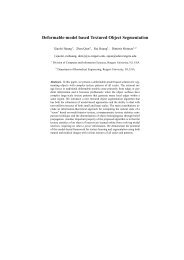
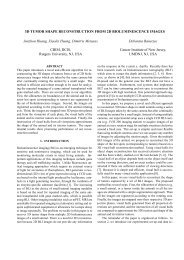
![Twitter[PDF]](https://img.yumpu.com/25710531/1/190x143/twitterpdf.jpg?quality=85)
